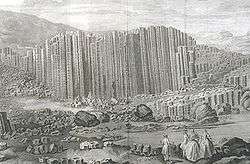Susanna Drury
Susanna Drury, later Susanna Warter[1] (c. 1698 – c. 1770) was an Irish painter. Though little is known of her life or work, she was very influential in the development of Irish landscape painting. She is chiefly noted for her watercolor drawings of the Giant's Causeway in County Antrim, which brought international attention to the site.
Susanna Drury | |
|---|---|
 Engraving of Drury's A View of the Giant's Causeway: East Prospect | |
| Born | c. 1698 |
| Died | c. 1770 |
| Nationality | Irish |
| Known for | painting |
Life
Drury was born around 1698. She was associated with the Dublin Society (later the Royal Dublin Society), which presented her with its first award, worth £25, in 1740 for her paintings of the Giant's Causeway.[2] She had traveled to Ulster to observe the site firsthand, and spent several months there working. Her drawings are composed of gouache on vellum and present two views of the Causeway from the east and west. These paintings show accurate details of the jointing forming the basalt columns of the Causeway. The paintings brought attention to the formation, and the popularity of Irish monument paintings boomed in their wake. Engravings were made by Francois Vivares between 1743 and 1744. Prints made from these engravings were popular in Europe and were widely circulated in scientific communities; in 1765 an entry for the Causeway appeared in volume 12 of the French Encyclopédie which clearly relied on the engraving of Drury's paintings. A plate made from the engraving of Drury's "East Prospect" itself later appeared unattributed in a volume of plates published for the Encyclopédie. It was included in the geology section along with two other plates depicting similar basalt formations in France, and included a caption by Nicolas Desmarest proposing, for the first time in print, that the structures were volcanic in origin.[3]
Drury married a man named Warter and died in or after 1770.[1] Her original gouache drawings of the Giant's Causeway now hang in the Ulster Museum in Belfast.
Notes
- Susanna Drury. Oxford Dictionary of National Biography. Retrieved January 10, 2018.
- Arnold, Irish Art, p. 62.
- "Susanna Drury, the Causeway, and the Encyclopédie, 1768" This was to help resolve a long-argued dispute on the origin of the basalts, and other igneous rocks, that had raged between the Neptunists and the Vulcanists. Archived 2006-09-28 at the Wayback Machine. Lindahall.org. Retrieved March 14, 2007.
References
- Arnold, Bruce (2002). Irish Art: A Concise History. New York: Thames & Hudson. ISBN 0-500-20148-X
- Anglesea M. and Preston,J.(1980). 'A Philosophical Landscape': Susanna Drury and the Giant's Causeway. Art History, 3, 252-273.